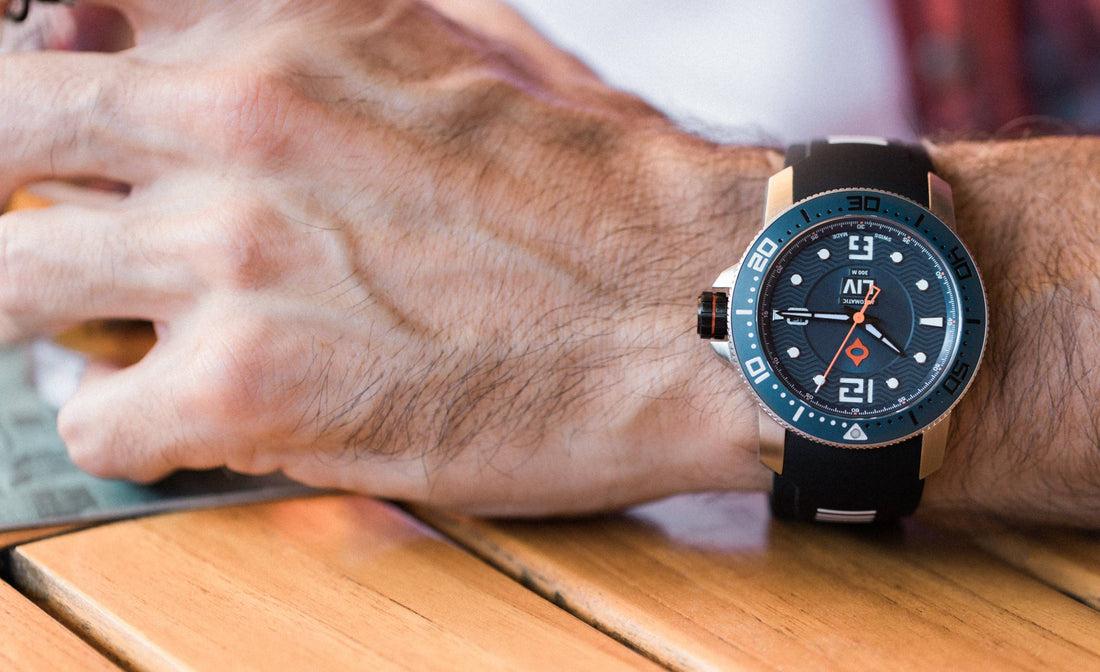WHAT DOES A BEZEL DO?
Before we dive (you'll see why I choose this word shortly) into the topic of bezels, let's pause for a brief definition.
"A bezel is the ring around the face of the watch. It can be fixed or it can move. If it moves, it can be uni-or bi-directional. It is marked in some fashion, most typically with dots, triangles, numbers, or simply, screws. Finally, the bezel may be treated to a strategic or artistic application of lume."
All right, now, what exactly does a bezel do for the person wearing the wristwatch? Aside from a purely aesthetic purpose (many fixed bezels are like this), the bezel serves as an elapsed time indicator. In order to serve in this capacity, the bezel needs to possess certain features:
 It must rotate
It must rotateIt must have hour markers and preferably minute markers as well
It should have a 12 o'clock marker that is distinctly different from all the others. A triangle or domed feature is common.
When the wearer wants to keep track of how much time has elapsed, they rotate the bezel so that the 12 o'clock marker aligns with the minute hand. As the minute hand advances, the user can measure the elapsed time by where the hand is within the 60-minute range of the bezel. Pretty much foolproof.
In this day and age of cell phones and smartwatches, what value does this provide? Did I mention it was foolproof? It also isn't dependent upon internet signals or a battery to work. And, it is a cool complication.
I hear the "gotchas" in the background. You say it doesn't need a battery to work like a smartphone. What about a quartz watch? Yes, the quartz movement is battery-powered. However, it has a far longer life and is less prone to running out than our power-hungry electronics.
In other applications, it can be part of a slide rule complication (yes, it's a thing, especially in pilots watches) or a tachymeter for chronograph functionality.
FIRST USE OF BEZELS
Dive watches were typically larger than streetwear timepieces because they had to fit over diving suits and be large enough to easily read in low light conditions. The bezels came with notches or textured edges to allow the diver to easily set and adjust it while wearing gloves. A healthy application of lume was also a necessity at critical points on the bezel.
So, why unidirectional? You've already mentioned that bezels come in a bidirectional configuration. Diver safety is the reason. If the bezel could rotate clockwise (unidirectional bezels rotate counter-clockwise), the diver could inadvertently jar the bezel back, reducing the actual elapsed time and threatening their safety.
The first companies to introduce a true bezel on their diver watches were Rolex, Blancpain, and Zodiac in 1953, with Blancpain being the only one of the trio with the now-standard unidirectional bezel.
As simple and basic as this complication is, it is still standard equipment on diver watches today. As you might suspect, sophisticated dive computers are available that provide a dizzying array of features. If I were a diver, I'd love the dive computer for gadget geek reasons. I'd also have a diver watch, just in case.

STEEL - PROS AND CONS
- Easy to forge and machine
- Highly corrosion-resistant
- Tough as, well, nails steel
- Accepts a wide range of coatings (see our piece on IP coatings)
- Watchmakers are very familiar with adding lume to steel
- Won't break
- The finish can be scratched - an issue when diving around coral or shipwrecks
- While corrosion-resistant, it is not impervious to saltwater

CERAMIC - PROS AND CONS
Here are the primary benefits of ceramic:
- The color extends from top to bottom, so scratches are less visible
- Exceptionally scratch-resistant, so you don't have to test pro #1 very often
- Nearly impervious to hostile environments like saltwater or the blistering heat of atmospheric re-entry
- Lightweight and durable
- Ceramic bezels must be molded from powder under intense heat and pressure
- They are hard to machine after they are formed, so the dies need to have all features like position markers clearly defined
- They can break under the right (or unfortunate) set of circumstances

*NEW* LIV GX-DIVER'S 44MM FULL LUME
RUBBER, ALUMINUM, WOOD AND OTHER MATERIALS
Watchmakers don't limit themselves when it comes to bezel materials.
Some are made of anodized aluminum for better corrosion resistance. Unfortunately, these are prone to scratching and denting.
Rubber, like that used in bowling balls, is another choice because it is rugged and saltwater doesn't affect it. These have to be molded and are not the finest substance for fine detail work.
Then, there is wood, however, this is usually for appearance rather than durability or corrosion resistance.
LIV'S TAKE ON CERAMIC
When LIV started designing the GX-Diver’s, choosing ceramic presented a challenge and an opportunity. It was an opportunity to use a premium material that is still scarce in the watch world. But producing the bezel efficiently was also a challenge in developing the manufacturing processes.
The bezel is housed in a 316L stainless steel ring with pronounced texture on the edges. You could call it a coin edge treatment because it looks like the edge of a newly minted coin, on performance-enhancing substances, aka steroids. This allows LIV's craftspeople to machine a precise interface between the bezel and the watch case in steel that is more amenable to the work.

LIV 44mm GX-Diver's w/ Matte Ceramic Bezel
The molded bezel has 60 markers, one for each minute, of course. Five-minute marks are bars, ten-minute markers are numbers, and single minutes are dots. This visual interpretation of elapsed time is intuitive and very easy to read.
Some diver watches fill every marker with white paint or lume. While the supposed purpose is to increase visibility, in actual use, it can be confusing. LIV elected to apply lume in the critical twenty minutes to "time's up" markers with premium lume. The rest of the markers are filled with glossy epoxy. The user can easily measure elapsed time and is given elevated visibility of the critical last twenty minutes of the dive.
If you are in the market for a premium Swiss-made divers watch at accessible prices, you owe it to yourself to pick up a GX-Divers.
FOUNDERS' THOUGHTS
Esti: Bezels provide a very useful (and reliable) elapsed-time tracking functionality. In addition, they can add a real punch to the overall design.
Chaz: Our ceramic and titanium bezels gave LIV the chance to push the envelope on watch materials and engineering. Our success provides our fans with an incredibly durable, and good-looking bezel.


